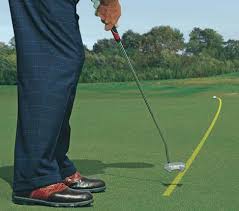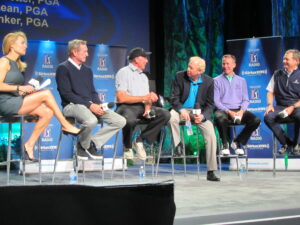I am currently receiving the “Save 1 Stroke Per Hole” series of Golf Tips from Todd Kolb. He also created my US GOLF TV video which was shot at a past PGA Merchandise Show in Orlando, FL. He is a PGA Professional Trainer who really understands the game. I just wanted to share his key tips which are really helping my game to “eliminate those nasty blow-up holes”.
We all know these tips. Pros have caddies to remind them to keep their game in check. Somehow our subconscious egos make us ignore the obvious. Snap out of your crazy rut and follow these rules to break 100, 90 or 80. You can do this by saving a stroke on all of your problem holes.
Keep your Ball in Play: Sort out your big miss and adjust your swing with a lesson or at the driving range before you play a round of golf. You may have to adjust your distance to the ball to avoid hitting off the toe or swing with less speed to avoid slicing the ball but do whatever is needed to keep your shots in the fairway. First learn to swing like a professional golfer and then adjust for your body’s strengths and weaknesses (because you may not have the perfect timing for every swing).
Get your Ball back in Play: If you end up in the rough, behind a tree or in a sand trap, make the shot that will get your ball in play. Yes you will waste 1 shot but you are avoiding a blow-up hole. [NOTE: mark your score code to identify what caused each blowup hole (T-tree, W-water, S-sand etc) and then plan to eliminate fix the shots that put you in those spots.]
Grab more Club: Don’t expect to hit every shot like the pros. Choose an extra club so that you can swing in control with an 80% swing. Focus on the perfect swing with less power to hit in the right direction. Swinging at 100% will kill your game as you lose control of many shots.
Know Your Shot Tendencies: If your driver always fades to the right, adjust your aim to the left and let it fad into the center of the fairway.
Know Your Club Yardages: At sea level in humid climates your ball will not travel as far as it does in dry warm air in higher altitudes. Knowing the distance to the hole is a good starting point but distance to clear a trap or a water hazard are even more important. Adjust your selection of clubs according to your situation and know the flight distance and roll distance of each club.
Chip with the Same Club: You should become an expert using 1 club for chipping (to lift over the approach obstacles and roll out on the green). The green elevation changes on every hole but if you use the same club for most chips then you will learn to trust your skill with that club. [A 6 iron to 60 degree wedge will do but I prefer my #4 hybrid as it will clear most obstacles and I eliminate fat chips too.] Your confidence using your favorite chipping club will improve your chances for a 1 putt green.
Walk off Putting Distances: For longer putts, don’t trust your feel for the distance. Walk it off and know what you have to do for a 30 or 40 yard putt over different elevations. Take practice swings with the tempo and backswing that will get your ball to the hole.
Use these TIPS or you can always hire a caddy for $100. Practice for every swing in your game and buy a GOLFSTR+ to swing like a pro. Buy one today at www.golfstr.com






 2/ CONSISTENT [CONFIDENT] HITS: Your goal is to create a consistent swing (for your drives, fairway shots, chips and putts – each club needs your unique swing thought). Justin Thomas takes very little time to prepare for each swing and then execute. [After Alabama lost in the college football championship, Justin had a lot of disappointment on him mind. He sure figured out how to focus. At the age of 23 he is the youngest play to set the lowest PGA tournament score at -27.] Justin has one swing thought for the club and shot that he is making. He steps up to the ball and executes that swing though and you should do the same thing.
2/ CONSISTENT [CONFIDENT] HITS: Your goal is to create a consistent swing (for your drives, fairway shots, chips and putts – each club needs your unique swing thought). Justin Thomas takes very little time to prepare for each swing and then execute. [After Alabama lost in the college football championship, Justin had a lot of disappointment on him mind. He sure figured out how to focus. At the age of 23 he is the youngest play to set the lowest PGA tournament score at -27.] Justin has one swing thought for the club and shot that he is making. He steps up to the ball and executes that swing though and you should do the same thing.




